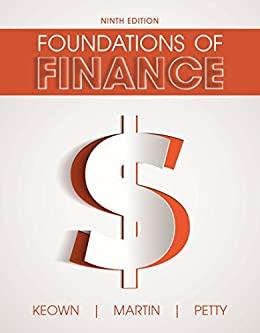New Wave Surfing Stuff Inc. is a manufacturer of surfboards and related gear that sells to exclusive
Question:
New Wave Surfing Stuff Inc. is a manufacturer of surfboards and related gear that sells to exclusive surf shops located in several Atlantic and Pacific mainland coastal towns as well as several Hawaiian locations. The company's headquarters are located in Carlsbad, California, a small southern California coastal town. True to form, the company's officers, all veteran surfers, have been somewhat laid back about various critical areas of financial management. With an economic downturn in California adversely affecting their business, however, the officers of the company have decided to focus intently on ways to improve New Wave's cash flows. The CFO, Willy Bonik, has been requested to forgo any more daytime surfing jaunts until he has wrapped up a plan to accelerate New Wave's cash flows.
In an effort to ensure his quick return to the surf, Willy has decided to focus on what he believes is one of the easiest methods of improving New Wave's cash collections, namely, the adoption of a cash receipts acceleration system that includes a lockbox system and concentration banking. Willy is well aware that New Wave's current system leaves much room for improvement. The company's accounts-receivable system currently requires that remittances from customers be mailed to the headquarters office for processing and then deposited in the local branch of the Bank of the U.S. Such an arrangement takes a considerable amount of time. The checks take an average of 5 days to reach the Carlsbad headquarters. Then, depending on the surf conditions, processing within the company takes anywhere from 2 to 4 days, with the average from the day of receipt by the company to the day of deposit at the bank being 3 days.
Willy feels pretty certain that such delays are costly. After all, New Wave's average daily collections are $150,000. The average remittance size is $750. If Willy could get these funds into his marketable-securities account more quickly, he could earn an annual rate of 5 percent on them. In addition, if he could arrange for someone else to do the processing, Willy could save $55,000 per year in costs related to clerical staffing.
New Wave's banker was pleased to provide Willy with a proposal for a combination of a lockbox system and a concentration-banking system. Bank of the U.S. would be New Wave's concentration bank. Lockboxes would be established in Honolulu, Newport Beach, and Daytona Beach. Each check processed through the lockbox system would cost New Wave $0.30. This arrangement, however, would reduce mail float by an average 2.5 days. The funds so collected would be transferred twice each day, 270 days a year, from each of the local lockbox banks to Bank of the U.S. Each transfer would cost $0.35. The combination of lockbox system and concentration banking would eliminate the time it takes the company to process cash collections, thereby making the funds available for short-term investment.
a. What would be the average amount of cash made available if New Wave were to adopt the system proposed by Bank of the U.S.?
b. What is the annual opportunity cost of maintaining the current cash collection and deposit system?
c. What is the expected annual cost of the complete system proposed by Bank of the U.S.?
d. What is the net gain or loss that is expected to result from the proposed new system? Should New Wave adopt the new system?
LockboxesLockbox banking is a service provided by banks to companies for the receipt of payment from customers. Under the service, the payments made by customers are directed to a special post office box instead of going to the company. The bank goes to the... Opportunity Cost
Opportunity cost is the profit lost when one alternative is selected over another. The Opportunity Cost refers to the expected returns from the second best alternative use of resources that are foregone due to the scarcity of resources such as land,...
Step by Step Answer:

Foundations Of Finance
ISBN: 9780134083285
9th Edition
Authors: Arthur J. Keown, John H. Martin, J. William Petty





